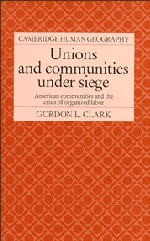Book contents
- Frontmatter
- Contents
- List of tables
- Preface
- Acknowledgments
- PART I ECONOMY AND COMMUNITY
- 1 Crisis of organized labor
- 2 Understanding union growth and decline
- PART II DRAMA OF ECONOMIC RESTRUCTURING
- PART III UNION PERFORMANCE IN REPRESENTATION ELECTIONS
- PART IV REGULATING LOCAL LABOR–MANAGEMENT RELATIONS
- PART V PROSPECTS FOR ORGANIZED LABOR
- Appendix 1 Variables and data sources
- Appendix 2 Cases cited
- Notes
- Bibliography
- Name index
- Subject index
1 - Crisis of organized labor
Published online by Cambridge University Press: 13 October 2009
- Frontmatter
- Contents
- List of tables
- Preface
- Acknowledgments
- PART I ECONOMY AND COMMUNITY
- 1 Crisis of organized labor
- 2 Understanding union growth and decline
- PART II DRAMA OF ECONOMIC RESTRUCTURING
- PART III UNION PERFORMANCE IN REPRESENTATION ELECTIONS
- PART IV REGULATING LOCAL LABOR–MANAGEMENT RELATIONS
- PART V PROSPECTS FOR ORGANIZED LABOR
- Appendix 1 Variables and data sources
- Appendix 2 Cases cited
- Notes
- Bibliography
- Name index
- Subject index
Summary
In an era predicted by some to be the mature, growth-consolidation phase of industrial unionism (Lester 1958), the United States labor movement is fighting for its survival. Industrial labor unions, the traditional centers of union power in the economy and in the labor movement, are particularly threatened. Some of these unions have lost as much as 40 percent of their membership base over the last decade. Not only have they suffered from economic restructuring, but these unions are winning proportionally fewer and fewer representation elections, contesting fewer elections, and winning only in smaller and smaller electoral units. Internally and externally industrial unions are under siege.
One startling aspect of recent patterns of union decline is that the survival of industrial unions is under threat even in their home domain: northern industrial towns and cities. Diversification strategies like the United Auto Workers' southern strategy have become practically impossible to affect. Declining membership is the norm, and growth of membership a distant memory. In contrast, over the past decade service workers' unions seem to have been able to extend their representation of American workers, though even this trend has slowed in recent years. With structural changes in the economy, large-scale displacement of industrial employment, and a relatively poor performance of industrial unions in representation elections, the flow of members to the American labor movement has slowed to barely a trickle.
- Type
- Chapter
- Information
- Unions and Communities under SiegeAmerican Communities and the Crisis of Organized Labor, pp. 3 - 21Publisher: Cambridge University PressPrint publication year: 1989



